The Zelda series is no stranger to enhanced ports and remasters, where Link's Awakening was the first game to receive an updated version for the GameBoy Color back in 1998 with Link's Awakening DX. And now, over 20 years later, it is the first Zelda game to get a remake that was built from the ground up.
It's also a Zelda game of many other firsts. It was the first Zelda game on a handheld system. It was the first Zelda game that didn't take place in Hyrule and that didn't revolve around the Triforce, where instead it puts Link on the mysterious island of Koholint. It was the first Zelda game without an appearance of the eponymous princess. It was the first Zelda game with a trading sequence or a fishing mini-game. It was the first Zelda game with boss keys. ...
This list goes on, but most importantly Link's Awakening was the first Zelda game for many fans. When you inserted its cartridge into the GameBoy, a magical world awaited you, like nothing you had seen before on the system. It's a game that holds many dear memories. And with this it's of utmost importance that such a remake manages to capture the magic of the original, living up to the memories of its fans and creating new ones for those who are experiencing the game for the first time on the Nintendo Switch.
This blog probably wouldn't even exist if it weren't for the original game, where there's a certain bias present. And the remake has stayed remarkably faithful to the GameBoy and GameBoy Color versions, so there's no point in reviewing the game overall, where instead this review will focus on the qualities of the remake alone.
The remake got developed by GREZZO, who are no strangers to porting and remastering Zelda games and where this has been their fifth Zelda project, following Four Swords: Anniversary Edition, Ocarina of Time 3D, Majora's Mask 3D and Tri Force Heroes. Their work can be quite hit-and-miss, so let's see how much hit and how much miss is in the remake of Link's Awakening...
Overview
Link's Awakening on the Nintendo Switch is a full-fledged remake, meaning that the entire game was rebuilt from the ground-up. It's for the most part a very faithful recreation of the original game, almost on a tile by tile basis, but everything runs on a new engine (seemingly Unreal Engine 4) with pretty new graphics, sounds and even some physics.
The remake was based on Link's Awakening DX for the GameBoy Color, but not in every aspect. You get the Color Dungeon, the Owl Statues and Stone Beaks that allowed multiple hints in dungeons, as well as the altered treasure contents of the DX version. The photo house and the related photo quest are gone, however, but some of its events have been preserved.
And this is also based on the censored version in all regions now, so no bare-breasted mermaids looking for their Bikini Tops. But since you now see below the water surface, this should be understandable. Scripts and translations have also been based on the latest version from the Nintendo 3DS Virtual Console, with some alterations and additions, of course. And now the game offers many more languages than it did in the past.
The focus of the remake clearly was on updating the game in terms of graphics, sound and interface, but of course there are also some new additions and improvements, including new collectibles, enhanced mini-games, a new Hero Mode difficulty and also the Chamber Dungeon feature.
Graphics and Visuals
One word: beautiful. There rarely is media franchise as rich in variety as The Legend of Zelda when it comes to the art style. Ever since The Wind Waker the series has been redefining itself visually, from bright and cartoonish to dark and realistic, where the remake of Link's Awakening now goes for adorable and colorful.
This new style might not be to everyone's taste, but it does its job nicely, where it took the sprite-based visuals from the GameBoy classic and turned them into a plastic diorama style. And this looks really beautiful and fresh, yet at the same time stays quite close to the original. Everything feels like a little toy world, where it's often a tile-based recreation of the Koholint as we know it from the GameBoy, yet at the same time it's all bursting with new details.
Especially the different houses on the island have received a significant makeover, both on the inside and the outside. On the GameBoy most of the houses looked the same, but here there many details to be discovered. This is quite similar to Ocarina of Time 3D, where someone at GREZZO must secretly want to be an interior designer, but it definitely helps individualizing the game's characters, where a lot of love and charm went into designing all the houses.
The coloring of the GameBoy Color version has been ignored for the most part, where most of the dungeons have completely new visuals now, making them look more like actual dungeons. The island also looks a lot greener than it used to be and it was certainly a good decision to not stay faithful on that regard, because the remake looks really beautiful the way it was done.
However, the entire game is using a global light source for illumination, where this casts weird shadows slightly from the north inside the dungeons. It's not as distracting as in The Wind Waker HD, where some of the lighting inside the dungeons didn't make any sense at all, but it still is noticeable. At least the polished visuals of the dungeons fit the diorama style quite nicely, while they felt somewhat weird in A Link Between Worlds...
Speaking of the Nintendo 3DS game(s), quite a few assets from A Link Between Worlds have been translated into HD for this remake, most notably certain enemy designs, like Moldorm, Tektites or the Wizzrobes. But other things like Link himself have a completely new look to let them appear closer to the GameBoy style.
The other big change has been on the overworld, where the development team was going for a fully seamless experience, similar to Breath of the Wild. The overworld isn't segmented to single screens any longer, like it used to be on the GameBoy, and it's also not split into areas like A Link Between Worlds. Instead Koholint is one big area, where it keeps scrolling all the time for an impressive experience. You can always peak beyond the borders of your current area and see how everything is connected, which wasn't possible in the original game and just makes the world feel much more coherent and alive.
However, this came at a price. When you're on the overworld, the frame rate can take a hit here and there, especially when it's loading other areas or when there are many effects going on. This shouldn't be something that will kill the enjoyment of the game, but it's still noticeable, while there also can be some visible flickering.
The dungeons and caves always run at smooth 60FPS, however, and even make use of the scrolling for larger, connected rooms. However, small chambers still make use of the screen-based scrolling of the original to not break puzzles and the like, where even the new Chamber Dungeons are entirely made out of these individual rooms.
Other than the ingame graphics, there are also animated cutscenes for the intro and ending of the game. This was done in anime style, which tries to replicate the drawn scenes from the original game, but also feels reminiscent of the style of Akira Himekawa's Zelda manga. They are really nice, but for some reason they don't run fluidly, which is here a lot more distracting than any of the frame drops on the overworld...
Music and Sound
One word: beautiful. The GameBoy original had fantastic music, where for the remake Ryo Nagamatsu returns after his excellent work for both A Link Between Worlds and Tri Force Heroes on the Nintendo 3DS. And again he did a great job, where his re-arrangements range from quirky to absolutely epic. He engaged a small orchestra for this, which fits the simple 8-Bit music from the original very well.
For the most part the soundtrack of the remake is very faithful, but Ryo Nagamatsu has also taken some liberties here and there. The most notable new pieces are in the Angler's Tunnel and the Face Shrine, the Level 4 and 6 dungeons, where some amazing new tracks have been interwoven with the old GameBoy music. Especially the soundtrack for the Face Shrine more epic than ever and adds a tremendous weight to this part of the game.
On other ends the renditions can get a little bit silly or over the top, where for example you have cats and dogs singing the music in Animal Village. It fits the place and it sounds funny, but it might not be to everyone's liking. Some of the re-arrangements might also sound not as powerful as their counterparts on the GameBoy, like for example the new mini-boss music, which sounds less threatening as a result.
The new music (like for the Chamber Dungeon and one of the mini-games) also seems quite good, but is not necessarily on par with the compositions from the original. Especially the Chamber Dungeon music can get repetitive, if you're spending more time with the feature.
The sound effects are for the most part top-notch, but like with the music some of them can feel quite weak when compared to the GameBoy version. There the bosses and mini-bosses would release a metallic scream, whenever you hit them, and using either a Piece of Power or the Red Mail would throw enemies all over the screen with a powerful sound. This isn't true for the remake, where hitting enemies sometimes just sounds like cutting cardboard... But the rest of it is really good, like the iconic compass sound, Link playing the Ocarina or the nice pick-up melody for Secret Seashells.
Controls and Interface
As much as you could improve the graphics and sounds for the remake, there was an equal amount of potential to update both the controls and the user interface of the GameBoy original, which only had two buttons available for its actions. Link's Awakening was the first Zelda game to let you take off your sword and shield, so you could use other items in combination. But even for actions like jumping, lifting and running you had to equip the corresponding item, where as a result you had to open the inventory a lot to swap items.
Naturally, the Nintendo Switch version can make use of more buttons and therefore gives a good chunk of the items its dedicated input. Sword, Shield, Pegasus Boots and Power Bracelet are now always equipped and don't need to be swapped, which is very practical. However, the Roc's Feather is still one of the normal items, which have to be assigned to either the X or Y buttons. And since the Roc's Feather is essentially your jump button, you'll want to have it equipped most of the time, where you still keep going into the inventory quite a lot for the other items...
At the same time there would have been more room for additional inputs, so the game could have made things even more comfortable. Link's Awakening doesn't support single Joy-cons, but outside of the Chamber Dungeon menus the two Z shoulder buttons have the same usage as the respective L and R button: for the Pegasus Boots and Shield. And here it would have been a good idea to use the Z buttons either for additional item slots or jumping. Overall the game is lacking any configurations for the controls, where there could have been more options to let players control the game as they prefer it.
Also, the D-Pad isn't supported outside of menus as well, so only the Analog Stick can be used for walking. This would be understandable, if you could walk around freely in 360°, like you could in A Link Between Worlds and Tri Force Heroes, but like in the GameBoy original Link's movement is limited to eight directions. This feels a little bit weird at first, but you get used to it quickly and that the items also only work in eight directions feels more natural now than in did in the Nintendo 3DS Zelda games. But in any case the game should have supported the D-Pad for movement.
The user interface has taken a page from Breath of the Wild and went for its flat design, which looks pretty good and feels modern, but retains the sound effects of the original.
The remake also adds an auto-save feature, which is nice to have. There are still three save slots like on the GameBoy, but you can always save to any slot, similar to Twilight Princess. And when you are about to save, it doesn't show you the file number, where you have to worry about not overwriting an old save... This might feel like a nitpick, but accidentally deleting your previous 100% file certainly won't be a small issue, if that ever happens to you.
The biggest changes to the interface probably happened on the map, though. It's now super detailed to a point, where you can even see single rocks on it. It also marks important locations like dungeons or houses and like in Breath of the Wild you can put your own markers on it, but these mostly serve as reminders, because you don't have a mini-map in the game.
You can also recall important information, mostly what the Owl had to say at certain points (which was also possible on the GameBoy map) and the directions from the Instruments of the Sirens. But in addition there are maps that show you all the locations, where you've found Secret Seashells and Pieces of Hearts, which leads us to the next topic...
Seashells and Hearts
A Link to the Past introduced the first real collectible item to the Zelda series with the Pieces of Heart, where Link's Awakening on the GameBoy followed this trend and added another collectible on top with the Secret Seashells. There were 12 Pieces of Heart and 26 Secret Seashells to find in the original, where the remake has added to both of these counts. This is even the first time that collectible quests have been expanded like this and this helped adding more to the environments, especially places that have been near empty in the original.
As for the Pieces of Hearts, there are now 32 of them to get, 20 more than in the original. And this shows, because you can find them pretty much everywhere now. It even feels a little bit too much, because you can find them in almost every cave and you can stock up on additional Heart Containers (for a new maximum of 20) quite early in the game.
Finding the 12 Pieces of Hearts in the original felt much more special and rewarding than it now does in the remake. It was also harder, because some of them were quite obscurely hidden. In the remake you can now spot the sunken Piece of Hearts thanks to the new water graphics and cave walls that can be bombed now always have cracks on them... But now that they are easier to find, it only adds to the Heart Piece overkill.
It probably would have been a good idea to add even more Secret Seashells instead, because they are always fun to find and are usually not as easy to spot as the Pieces of Hearts – in fact they are always hidden in some way. There are 50 of them now in total, where the remake has added 26 of them. Yes, that means two of the original Secret Seashells are gone, but it's the two that used to be missable bonus rewards in the Seashell Mansion, which now offers a proper reward system, where you can't miss anything.
The better sword is still there and now takes twice as many Secret Seashells to get it, but you can still achieve this at the same point in the game. One of the new rewards is the Seashell Sensor, which vibrates and gives an acoustic and icon-based signal (similar to the Compass) whenever there is a seashell nearby. That makes finding all the seashells much, much easier, but luckily you can always turn the thing off, if you want to find them the old-fashioned way for a challenge.
With or without the sensor, it's fun to look for all the new hidden secrets all over Koholint, where there can be something new in every corner of this compact, little game world. And the remake really does a good job at adding secrets to places that didn't have any before. If you have played the GameBoy original and thought in certain locations that there had to be something hidden, but couldn't find anything, chances are there is now something there in the remake. And this is really satisfying. The only real complaint about the seashells is that there could have been even more of them and that the other rewards for them might feel somewhat lackluster.
In any case, whenever you find a Secret Seashell or a Piece of Heart, it would have been nice, if the game showed you the current total, like it did in Breath of the Wild with the Korok Seeds and Spirit Orbs. Instead you have to always open the inventory afterwards, which is inconvenient.
The photo quest from Link's Awakening DX does not return in the remake, as already mentioned earlier. A few of the photo events have been preserved, but you can't collect the pictures any longer. But since some of these pictures could be missed and one even required you to steal from the shop, this isn't necessarily a bad change for completionists.
It should also be noted that there is nothing missable in the remake at all, so everything can still be found at the end. Even the original GameBoy version had some Secret Seashells and one owl speech that could only be gotten at certain points, but all of this has been fixed in the remake, which is awesome.
And while the photos are gone now, the remake has added certain other collectibles instead: three Fairy Bottles, 10 Super Mario figurines and 14 Chamber Stones want to be obtained now in addition. But more on these later in the review, because for the most part those are connected to the island's main attractions, like the mini-games...
Mini-Games
A huge focus of the remake was updating the three mini-games on Koholint: the Trendy Game, the fishing and the Rapids Ride. In the original those offered some neat ideas and felt like a big step up from the simple gambling and target practice attractions in A Link to the Past. But they still didn't have much to offer, where you might have only played them once to be done with them. But now all of them were modernized with new mechanics and have plenty of rewards to offer, including two Pieces of Hearts and two Secret Seashells per mini-game, as well as the new Chamber Stones.
The Trendy Game probably got the biggest makeover here. The conveyor belt is gone and instead you have two moving platforms with items on them and three stationary items. This sounds much easier at first, but the crane itself now is completely based on physics, where the items can escape its grasp. And this can sometimes be frustrating, but once you get the hang of it, it's quite fast and fun and adds a nice diversion for in-between.
Luckily, they've added many new rewards to the Trendy Game. The original only had the Yoshi Doll, where here they've added two Pieces of Hearts, two Secret Seashells and one of the new Chamber Stones.
And because this wouldn't be nearly enough, there are now ten more Super Mario figurines to get after the Yoshi Doll, all based on the various Mario enemy cameos in Link's Awakening, like the Goomba or a Piranha Plant. Those can be placed on pedestals in the houses of Mabe Village and a new one unlocks after every major boss in the game, which gives you a reason to return to the Trendy Game after every major dungeon. This also makes this the mini-game with the biggest number of rewards in the entire Zelda series!
The fishing received a similar overhaul, where there's now some strategy involved to reeling in the fish, while there are three new types of fish and several new prices to get. Next to the obligatory Pieces of Hearts, Secret Seashells and Chamber Stones this includes two additional lures, which are sinking faster.
The new fish include the two cameos from the Super Mario universe and start appearing after dungeon 4, where like the Trendy Game the fishing gets gradually expanded, though not as often. Reeling in the Cheep-Cheeps and Bloopers can be more challenging, at first even somewhat frustrating, but like with the Trendy Game it's fun enough once you get the hang of it. It does go overboard with the rumble of your controller, however, where it's best to turn it off for the fishing and rely on the visual cues instead.
If a special fish is present right at the start, the pond will show a glowing, blue circle on the overworld to attract your attention. But unlike in the original new fish will keep entering the pond to replace the ones you've caught, where even the special fish can appear after a while, so there is no need for your to re-enter the pond, like for example in Majora's Mask 3D (also made by GREZZO). This alone is a huge improvement over all the fishing games in previous Zelda games, where for the first time you can just keep fishing to get everything eventually.
Last but not least, the Rapids Ride mini-game got updated as well. It now comes in two variants, the classic "Rapids Raid", where you collect any items in the area, and the new "Rapids Race", where you need to drive down the river as fast as possible. Both of these profit from another big change in the mini-game: you can now use the Hookshot to pull yourself to any of the trees. Also, you can now instantly replay the mini-game, once you've arrived at the bottom.
In the original there wasn't anything to get in the Rapids Ride other than Rupees, where the main reason to play the mini-game was to fill out all squares on your map. But naturally they've added Pieces of Hearts and the like now to give you a proper incentive to play both variants of the mini-game multiple times. Unlike the two mini-games in Mabe Village, where new rewards get unlocked after clearing dungeons, there is no reason to ever return to the Rapids Ride once you've cleared everything.
Overall the remake did a good job of upgrading the mini-games, where most of it is a lot of fun and gives you something more to do in between the dungeons. So, the remake of Link's Awakening is certainly one of the better examples when it comes to mini-games in the series.
Warp Points
Another important change to the game can be found with the warp system. On the GameBoy there only have been four warp points in total, which you accessed one after the other. If you stepped into one, you were sent to the next. In addition there was Manbo's Mambo, a warp song that teleported you to Manbo's Pond, right at Crazy Tracy's house, or back to the entrance inside a dungeon.
While all of this was sufficient, it has been improved greatly in the remake. Whenever you now enter a warp point now, you will be able to select your destination on a map. And playing Manbo's Mambo now lets you teleport to any warp point from anywhere, bringing up the same map menu. Getting the song also turns Manbo's Pond into a normal warp point as well.
There are also five new hidden warp points for a total of ten. All of these are in very useful locations, like Dampé's Shack, the Seashell Mansion and the west bay. However, while the mountains have gotten two more warp points as well, those can only be accessed very late in the game, so that you still need to cross the first, long mountain cave to get back to the central mountain area multiple times throughout the game. If this location had one more warp point, it would be perfect.
Other Environmental Changes
For the most part the game stayed remarkably faithful to the original, almost on a tile-by-tile basis. While everything looks much more detailed, it's still all in the same spots. Well, almost. GREZZO has taken some liberties here and there, but most of it was to improve the game in various way, e.g. to make things look prettier, to add the new warp points or to avoid issues.
For example there was a Secret Seashell that could only be gotten with the Flying Rooster in the original, making it missable. Now this can be gotten with the Hookshot, which is also required to enter the Signpost Maze now, since you need this item to solve the puzzle there.
An interesting change on the overworld is that there are now apples on certain trees. This was taken from A Link Between Worlds and like in that game there are red and green variants, where the green apples are rarer and healthier.
A nice mechanic change to the dungeon also keeps any locked doors open, once you've already cleared the rooms before. In the original you were sometimes forced to beat certain enemies again and again, if you went through the same rooms multiple times. But now the doors stay open, which is very convenient and saves you some time.
Another notable change comes with the cracked walls that can be destroyed via bombs. On the GameBoy many of them had the visible cracks only on one side, so that certain rooms were harder to find, but in the remake pretty much all bombable walls now have cracks on them. The only exceptions are inside Level 3 and the hidden shortcuts in Level 8...
While some of these cracked walls can be still difficult to spot, always showing the cracks kind of goes against the idea of secret rooms. This effectively turns them into another type of door instead of being a hidden passage that you need to find methodically. With the Pieces of Hearts in certain caves this is fully understandable and even a good change, because you don't really want to check every single cave wall in the game with your sword to make sure that you didn't miss anything. But inside certain dungeons this ruins some good puzzles.
The worst offender here is easily Level 6, the Face Shrine. The entire main puzzle of this dungeon revolved around two secret rooms in the "eyes of the map", hidden behind walls that can be blown up, but don't show any visible cracks. Not only does the remake blatantly spoil the existence of these rooms on the map screen now, it also shows cracks where you need to proceed, which makes solving this dungeon for first timers way too easy. The same is also true for the hidden crystal switch in Level 8.
And such changes, where the game was made needlessly easier, are certainly a shame, since the original game was already quite easy. Which brings us to...
Enemies
Link's Awakening never really has been a hard game and the remake didn't change this for sure with its reworked enemies. On some ends it made things tougher, on other ends it became easier. One example would be the Moblins or similar foes, which use either spear or sword and shield. The spear variants have become much more dangerous, since they now actively target you and keep their distance from you. At the same time the enemies with sword and shield can now easily be defeated by blocking them.
It's similar for the bosses. Some of them were made easier with the most notable example being Moldorm: the chamber is now bigger and there are cracked floors above the abysses on the sides, so you don't fall off as easily. Most people might not ever notice that the fight can reset by that and the Evil Eagle fight now won't reset at all... if you fall down now, you will potentially land on some spikes instead and he will keep spamming feathers, until you get back up.
Some (mini-)bosses on the other hand got buffed, mainly by acting more aggressively or by taking more hits. They are all still quite easy to beat, however, despite the buffs. It's good that the remake stays faithful enough that it didn't alter the bosses in bad ways like GREZZO did in Majora's Mask 3D. But at the same time some tougher challenges would have been nice here and there.
However, the main reason why the bosses are still too easy is because the enemies have little to no invulnerability frames. You can hit them in rapid succession with your sword, where each hits gets registered. This way the bosses can have all the health in the world – it won't help them, if you can hit like a machine gun. A Link Between Worlds had a similar problem, but at least the enemies aren't stun locked by your attacks any longer. This means a Hinox can still charge right through your attacks, making them a big threat in the remake, where they have become even more aggressive with their grab attacks.
Also, some of the bosses can't be defeated easily any longer, because some of the items have been nerfed...
Items
On the GameBoy you could only use two items at the time, which is why items like the Hookshot did act as a proper replacement for the sword and could potentially even kill bosses in a few hits. This isn't fully the case in the remake any longer, where for example the Hookshot now only stuns enemies – even small ones like the Keese. But the Hookshot got it the worst, where at least the Boomerang, which is like a secret weapon in this game, is still quite deadly and useful. It doesn't one-shot certain bosses any longer, however.
Apropos Boomerang, in the remake you don't have to give up one of your items for it any longer. You still need to trade the Shovel at first, but you can buy it back for 300 Rupees. And with the many new Secret Seashells the Shovel will even stay useful much longer.
The upgraded sword will now also break pots, which is very handy, while the Mirror Shield now returns all projectiles, potentially killing the sender. The Red and Blue Mail from the GameBoy Color version are still available, but they have been balanced differently and you can now also get back the green tunic at any time. All nice little tweaks to the existing items.
Also, there are now three new items to be found in your inventory in the form of Fairy Bottles. Like with empty bottles from other Zelda games you can use them to store and release fairies. However, that's their only use in this game. The fairies will heal seven hearts and won't work automatically this time – you still have the Secret Medicine for this.
Speaking of, like in the DX version you can find a chest with a Secret Medicine in each of the last three dungeons. But unlike the DX version you will put the medicine back into the chest, if you already have one in your inventory. Like with the Rupees in the original versions of Twilight Princess, this can be quite annoying, if you want to clear your dungeon maps from all chests...
Anyway, in the normal game the new Fairy Bottles probably won't see any use from experienced players, so they are first and foremost a way to get the inventory back to twelve slots, which makes it look more even. However, they can be quite useful in the new Hero Mode...
Hero Mode
Almost every new Zelda game comes with an extra difficulty mode these days (the only exception since Skyward Sword has been Majora's Mask 3D), where the remake of Link's Awakening offers a simple "Hero Mode" right from the start, similar to Twilight Princess HD, just without the flipped map. Whenever you start a new save file, you can choose between Normal and Hero Mode, where the latter adds a little boss icon to the file and the bottom left of the screen.
In Hero Mode you will receive double damage and you won't find any hearts, apples or fairies with a few exceptions. If you want the latter for your Fairy Bottles, which are now suddenly very useful, you now have to visit one of the three Fairy Fountains inside caves... Even the mini-bosses don't leave fairies any longer. But this doesn't really make Hero Mode any more difficult, only more inconvenient. If you want to heal after any of the mini-boss fights, you will now have to leave the dungeon, find a Great Fairy and then return.
Overall this Hero Mode suffers from the same problem as the ones before: it only makes the early game tougher. Later on the increase in difficulty is hardly noticeable, especially after you can got the Blue Mail from the Color Dungeon, which effectively negates the double damage. And the removal of apples and fairies kind of makes it feel there is missing something.
A better way to increase the difficulty would have been to alter the dungeons or to increase the amounts of enemies. For the latter the game even offers a mechanic, where existing enemies can be doubled inside the Chamber Dungeon, with the "+Monsters Effect". If Hero Mode were to apply this effect to the entire game, it would already have been a lot more interesting.
Postgame
The remake of Link's Awakening now lets you save after the credits, where similar to Breath of the Wild the save file will have a star on it. It also then shows the total of Pieces of Hearts and Secret Seashells inside the memories, which is a minor change, but might be useful for someone, who is completing the game for the first time.
This post-game also lets you obtain the last figurine in the Trendy Game for some reason, which then also gives you the "+Monsters Effect" for the Chamber Dungeon, where it's not possible to 100% complete the game until after defeating the final boss... Speaking of, saving after the final boss would have been perfect for adding contents from the Windfish's Egg to the big new feature of remake: the Chamber Dungeon. But this doesn't happen...
The Chamber Dungeon
The Chamber Dungeon is without a doubt the biggest addition to the remake of Link's Awakening and you might be expecting a large section about this feature at this point in this review. But since this is such a huge addition and it feels so much like a game within a game, Hyrule Blog will publish its own, separate Chamber Dungeon Review right afterwards.
Conclusion
The Legend of Zelda: Link's Awakening on the Nintendo Switch is a finely crafted remake, which should satisfy most fans of the original and let others experience the GameBoy classic for the first time with a beautiful new livery. It's for the most part a very faithful remake, carefully recreating the world of Koholint by every square, while at the same time it isn't afraid to take liberties to improve the game on all ends, like with the fully updated mini-games.
The only real complaints lie in the occasional performance drops on the overworld and the lack of control options. There are also some things left to say about the new Chamber Dungeon, but this feature will be discussed in its own review.
The Good:
- Faithful remake
- Smooth gameplay
- Beautiful visuals
- Solid soundtrack
- Improved controls
- Auto saves
- Many new Secret Seashells and Pieces of Hearts
- Updated mini-games
- Trendy Game figurine collection
- No missable rewards / items
- Better warp system
The Bad:
- Occasional frame drops on the overworld
- Some sounds feel weak compared to the original
- No D-Pad support for walking
- No dedicated jump button
- Bosses are still too easy
- Uninspired Hero Mode
The Nitpicks:
- Early mountains could use another warp point
- The main puzzle of the Face Shrine got removed
- Secret Medicine now blocks chests when you already have some


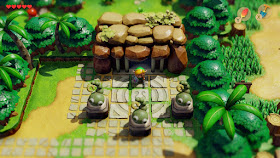



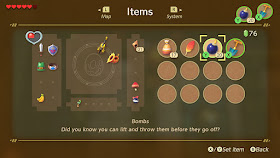

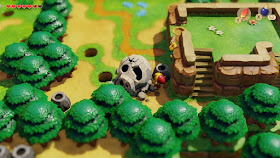
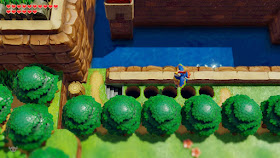
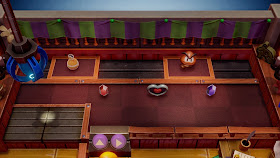

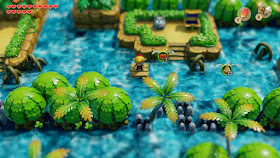
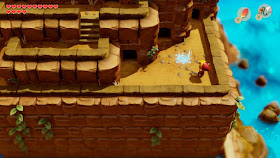
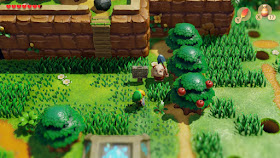
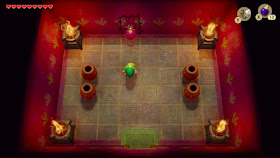
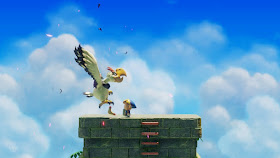

I agree with most of your comments, but I still think that the photo quest shouldn't have been removed from the remake. They could have modified them so that there is no missable photos, and even add more, the same they did with the secret seashells.
ReplyDeleteFirst, they could have added an option to have your companions back at any time, just for fun. I think this should be available in the postgame, which would give you a motivation to explore again the world. You talk to Marin, for example, and you can take her back for a walk. The same with the ghost, Bow-Wow and the flying rooster. This should come with some limitations of course: you can only have one companion at a time, and they cannot enter the dungeons. With this, any photos related to Marin wouldn't be missable anymore (and we can have back the family meeting at the weather vine!). But this also has many more possibilities with more interactions (and more photos of course). Just imagine Marin swimming with you, so funny!
There could be different versions for the same photo. An example is the one with Richard. First, he should only appear for the photo after you have talked to him (to make sense). And the photo could be either with the gate open or with the gate closed. And you can reactivate the swith so you can open/close the gate any time you want. Other example for these alternative photos could be a photo with the Great Fairy in the Color Dungeon, where you appear in the photo with the tunic you just chose. Ideally, you should be able to see all the different versions in the album, so there isn't anything missable. By the way, the first photo in the DX version of the game already have exclusive versions. There is no reason why you can't have both, just by talking again to the photographer and asking for another photo.
Then, there is the famous photo of Link stealing in the Item Shop. A lot of people didn't like this photo for its obvious consequences. But personally, I always loved the fact that you could steal items. The solution? You can steal an item, for the first time, and when you go outside the Photographer is waiting for you and tell you that stealing is not right and that he will return the item back for you. With no consequences. Then, you have the photo (which is very amusing) and nobody will call you thief. Then, you are free to steal again as usual.
My point is that the photo sidequest had some issues, but they can fix them if they want. Another collectible is always good if it is implemented well. I always saw the photos as an incentive to explore the world even more. If they expand the idea, and with the possibility to bring back your companions to have more interactions with the world, it would be a nice addition.
@Lankelink:
ReplyDeleteThanks for the comment, those are some good thoughts and ideas.
When the remake got announced earlier this year, I also brought up that you should be able to re-unite with your previous companions somehow. In fact that's one of the few suggestions that didn't make it into the remake:
https://touriantourist.blogspot.com/2019/02/links-awakening-remake-potential.html
It certainly would have helped with the missables from the earlier versions. Still, I never liked the photo quest that much to begin with, which is why its absence didn't end up as a negative point in this review.
If they were able to pull it off your way, I certainly wouldn't be against it, though. But those are a lot of variables to consider just to make the photo quest work without any missables... And since it was primarily added for the GameBoy Printer (even though rarely anyone used that), it's understandable that they didn't bring back this feature.